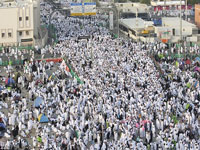 Heavy rush of pilgrims after Mina ritual.
Heavy rush of pilgrims after Mina ritual. Over 770 pilgrims were killed in a horrific stampede at Mina in Saudi Arabia on September 24, 2015. The tragedy occurred when Muslims around the world were observing the Islamic festival Eid-ul Azha. It seems that the available media reports vary while official reports are more confusing although Saudi Arabia's General Directorate of Civil Defence (GDCD) reported that 769 pilgrims were killed and 863 injured. Besides, Iran claims the estimated death toll is more than 2,000. However, the Mina stampede tragedy is the deadliest tragedy in history to strike Islam's annual pilgrimage called Hajj.
Most victims were crushed and trampled to death while performing the symbolic stoning of Satan - a necessary Hajj ritual of throwing pebbles against three stony columns at Mina. Mina is a large valley about 5 km from Mecca that houses over 160,000 tents where pilgrims spend the night. According to Saudi officials, the tragedy struck at the intersection of two streets during a morning surge of pilgrims who were making their way toward Jamarat Bridge - a multi-storied structure designed to ease the crowd's pressure and prevent pilgrims from being trampled. As the rescue crews rushed the injured pilgrims to nearby hospitals, helicopters hovered overhead and ambulance sirens blared. Rapidly, more than 220 rescue vehicles and over 4,000 emergency servicemen were deployed to ease the congestion and provide alternative exit-routes.
Moreover, Associated Press (AP) confirms that the disaster started when one wave of pilgrims found themselves heading into a mass of people going in another direction. Survivors saw that some of the pilgrims tripped over others in a wheelchair while several others tripping over them and some were even climbing over each other just to breathe! Like a wave, people went forward and suddenly came back in two large flows - this should never have happened. Evidently, the Saudi authorities were not prepared.
It was the second of the two major disasters during this year's Hajj. Globally, Muslims doubt the adequacy and sufficiency of measures put in place by Saudi Arabia to ensure the safety of roughly 2 million pilgrims. On September 11, a giant construction crane crashed down on the focal point of Hajj - Mecca's Grand Mosque. The mishap killed 111 pilgrims including a Bangladeshi and injured more than 390 people including 40 Bangladeshi nationals. The Saudi government blamed the crane collapse on high winds during an unusually powerful storm and faulted the construction giant Saudi Binladin Group for not following operating procedures.
Saudi Arabia takes great pride in its role as the sole custodian of Islam's holiest sites and an annual host to millions of Hajj pilgrims. Nevertheless, Hajj poses an immense logistical and security challenge for the oil-rich kingdom as countless Muslims from various countries gather every year. King Salman of Saudi Arabia ordered the creation of a committee to investigate the tragic incidents, although such incidents happened in a moment and there was no indication that Saudi authorities were to blame for the event.
Amateur video shared on the social media showed a horrendous scene - scores of bodies lying amidst the crushed wheelchairs and water bottles on sun-baked streets. However, the global media covering the Hajj were restricted from visiting the tragic site for several hours. Photos released by GDCD on its official Twitter showed rescue workers helping the wounded onto stretchers before loading them onto ambulances. Dozens of bodies could still be seen on the streets at dusk despite the presence of ambulances and freezer-trucks to haul away the dead.
According to Iran's official news agency IRNA, more than 95 Iranian pilgrims were killed. Saeed Ohadi, the chief of the country's Hajj organisation, declared that "mismanagement by the Saudis" led to such tragedy. Iran's Deputy Foreign Minister Hossesin Amir Abdollahian has summoned the Saudi ambassador to Tehran for an official protest over what he called "inadequate performance of Saudi authorities in the incident". Out of 100,000 pilgrims from Bangladesh, at least 11 pilgrims were killed in the stampede and 98 pilgrims are still missing as of September 26, 2015.
However, Saudi authorities claim that extensive precautions had been taken to ensure the safety and security of pilgrims during the Hajj - an obligation to every able-bodied Muslim who can afford it. Over the years, Saudi Arabia has taken numerous measures to alleviate the pressure posed by masses of pilgrims converging on the site of the stoning ritual at Mina. Plus, Saudi officials have been using surveillance cameras and other necessary equipment to limit the number of people converging on the site. The Jamarat Bridge has multiple exits to facilitate the flow of people. Yet, tragedies took place.
The Saudi government should be more careful and take cautious steps during the Hajj so that deadly incidents are avoided in the long run. Hopefully, millions of pilgrims who gather from different corners of the world would return home next time - without facing the death caused by a stampede and similar accidents.
The writer is a retired Professor of Economics, BCS General Education Cadre.
© 2024 - All Rights with The Financial Express
